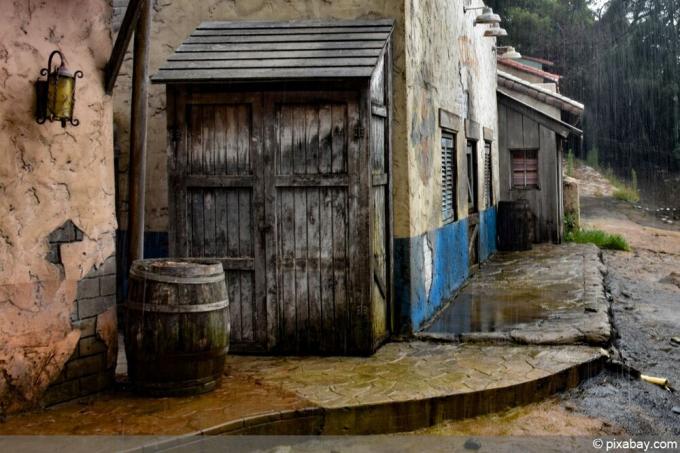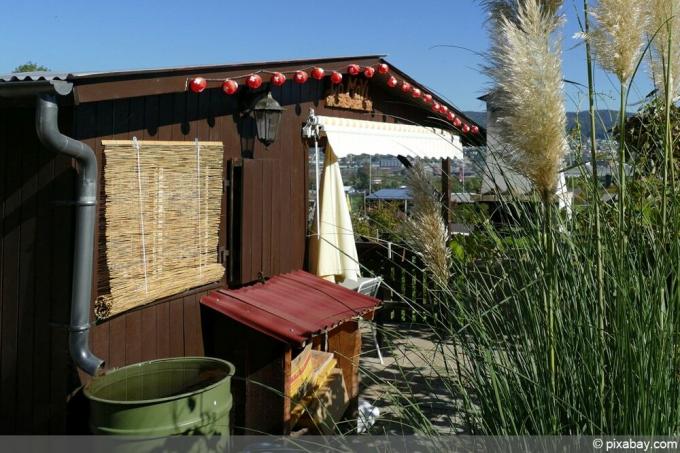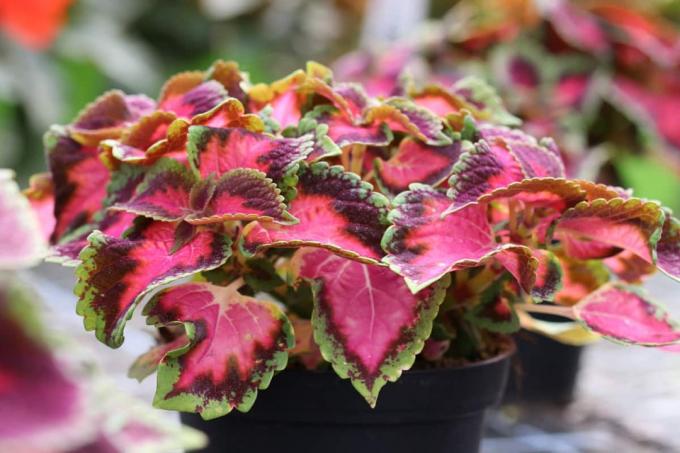

Table of contents
- Danger of frost for rain barrels
- plastic bins
- wooden barrel
- metal water butt
- Rain barrels with slides
- Drain properly
- Antifreeze preparations
Whether and how you have to prepare your water butt for the winter depends primarily on what material it is made of. The material and processing quality and the location also play a major role. To ensure that your water butt gets through the winter safely and undamaged, you should take the right measures in good time.
Danger of frost for rain barrels
The combination of water and UV sunlight evenly removes plasticizers from plastic rain barrels. The material becomes brittle. If water remains in the rain barrel in winter, it takes on more volume when frozen. That is, it spreads and pushes against the walls. The more brittle the walls are, or the lower the quality of the material, the more likely it is that cracks will form on the barrel walls. The water butt leaks and, in the worst case, can even burst over a large area.
plastic bins
Not all plastic water butts are robust in frost. As a rule, frost-resistant rain barrels are made of flexible polyethylene. This is not only environmentally friendly, but usually also weatherproof and frost-proof. But be careful, because in many cases the frost resistance is limited to certain minus temperatures. In some cases, a frost resistance of up to minus ten degrees Celsius is specified. But in many cases frost resistance requires draining or at least lowering the water level. If the temperatures drop significantly below, only very few plastic rain barrels can withstand the cold.
Rain barrels with welded seams are particularly susceptible to cracks and bursting. In connection with an inferior quality, they usually do not survive the first days of winter. You can find out from the manufacturer whether your plastic water butt is cold-resistant.
winter location
If you have a frost-proof water butt, you can usually use it during the cold season Stand still as long as the temperatures do not fall below the temperature specifications set by the manufacturer fall. Basically, it is advisable to offer every plastic rain barrel a wind-protected place in winter. Icy winds can put additional strain on the material and damage even frost-resistant water butts.

If an extremely cold winter is expected, you should play it safe and move your water butt to a warmer location, as would non-frost hardy specimens.
If your plastic rain barrel is embedded in the ground, you don't have to worry about frost-resistant models. Ground frost usually only refers to the first centimeters of the earth's surface. It will not cause any problems for the buried rainwater tank. In addition, the earth around the barrel keeps the walls stable and no expansion of the water content due to freezing is to be expected when the tank is fully embedded in the earth.
emptying/water level
For frost-resistant plastic rain barrels that overwinter outdoors, the water level should not be higher than 75 percent. A low water level is ideal. In this way, the freezing water can expand upwards. This relieves the barrel walls and significantly reduces the risk of damage.
However, the residual water usually creates an additional layer of ice. If this blocks upward expansion, this has the same effect as if the barrel were completely filled with water. For this reason, it is essential that you regularly check your bin for layers of ice in winter and break open/remove them.
Frost-sensitive models
If your rainwater tank is not a frost-proof model, it must be drained completely. While flexible polyethylene can withstand small expansions, even a few millimeters of expansion pressure can lead to cracks in rigid materials.
wooden barrel
Wooden barrels are very popular as water butts, but they require special care, especially for the wet winter season. This should be applied to the exterior walls in the summer in the form of an impregnation layer. A combination of moisturizing and weather-protecting properties is recommended. If metal or cast iron rings encase the wooden barrel, care must be taken to ensure adequate rust protection so that stability is maintained and longevity is supported.
winter location
The wooden barrel can be left to overwinter outside or in a frost-free place. Outdoors, it is naturally exposed to the cold weather. Since wood is robust and, in principle, extremely winter-proof, it is not necessary to move it to a warmer place.
emptying/water level
As a rule, three quarters of the bins can remain filled with water in winter. This is also recommended, as the water pressure keeps the wood "in shape". If you were to empty the wooden bin completely, the wood would contract. This means that the bin will probably leak in some places when it is filled next year. However, this corrects itself automatically after a few days, because the moisture in the water then causes the wood to expand again and thus the desired tightness.

A metal water butt does not offer flexibility of the walls. If frozen water expands here, there is a high risk that leaky welds and soldered joints will develop or even the material will tear open completely. Some people leave a little water in the barrel over the winter so that it becomes heavier and the rain barrel does not fly away in the wind. However, the residual water can also create additional ice surfaces here, which prevent upward expansion. With metal water butts, this can very quickly lead to damage, especially at the transitions between wall and floor, if you do not break up the layer of ice immediately. However, since you probably do not want to check every day, it is advisable to always leave the water out of the metal water butt.
Rain barrels with slides
A special feature is the rain collection container, which is lined with a film on the inside. These are usually rain barrels, the outer walls of which only serve to guide/hold the foil. Most of these are bottomless. This is represented by the slide. As a rule, the films are frost-resistant and can overwinter outdoors. The border is mainly made of wood or flexible winter-proof polyethylene. In winter, however, there is a risk of foil damage from stones or similar sharp-edged objects. When frost freezes the water and as a result the film loses its freedom of movement and pebbles through the water weight cannot be pushed into the frozen ground, these small holes in the ground can cause.
Drain properly
With drain hole
As a rule, every type of rain barrel from the trade is provided with a drain opening or screw connection that is used for emptying. This is usually located on the barrel wall just above the base plate. Depending on the type of closure, it can be opened easily by hand or has to be unscrewed with a screwdriver, for example.
Depending on how far you want to empty your water butt, let the corresponding amount of water run out of the drain opening. The water level can only be lowered to the height of the drain hole without your intervention. By tipping the rain barrel in the opening direction, more water flows out. You can only get the remaining water out of the rain barrel by overturning it. In many cases it is necessary to open a cover or another inlet/outlet opening in the cover.
Without drain hole
Most are wooden barrels or barrels that are not used for their intended purpose and are used as rain barrels if there is no drainage hole. But there are also rainwater storage tanks that only have a cover opening and do not have a drain pipe underneath.

In this case, the bin can only be emptied by overturning it. Especially when a rainy autumn causes a high water level, emptying can become a difficult task that not everyone is up to. Here it is advisable to prevent the water inflow at an early stage so that the weight of the water butt is reduced for the imminent tipping over.
Closed column or underground tank
In the case of designs that have neither a drain nor an inlet opening or underground tanks that are fully or partially embedded in the ground, emptying is different. A water pump with a hose is required for underground tanks, with which the water can be drawn out of the tank. Hose sets are available for closed column tanks, which subsequently create a drain option.
Tip:
When rain barrels are completely emptied, this is the perfect moment to do a thorough cleaning. In this way, you can use a high-pressure cleaner or water hose and brush to remove algae and dirt from the interior, for example.
Antifreeze preparations
If rain barrels do not overwinter in a frost-free place, further preparations for the winter should be carried out, regardless of the material, frost resistance and emptying/filling. These include:
- After emptying, prevent further water inflow
- Close with a lid or cover the top with something similar
- Wrap the rain barrel in foil (extends the life of the material)
- Tip over completely empty rain barrels and weigh them down to prevent them from flying away
- Place frost-sensitive, empty rain barrels on styrofoam, cardboard or wood (isolating effect against ground frost)
- In the case of partially empty barrels, straw or reeds in the water prevent complete freezing
 Home editorial office
Home editorial office
Learn more about overwintering plants

Eucalyptus dries up during the winter: what to do?
Eucalyptus in tubs spends the winter best in a frost-protected place in the house. It is not uncommon for the beautiful eucalyptus plants to dry up during the winter. We show what you can do about it.

Is bamboo hardy? Hibernate bamboo correctly
A bamboo can undoubtedly enrich any garden. But can it survive winter temperatures in good health? There is no general answer. It depends on the species and what winter protection it gets.

Is the colored nettle hardy? 6 tips for wintering
Summer is the season when the colors of these ornamental foliage plants are at their most intense. Most of the leaves are multicolored, with different drawings, wavy or heavily slit edges.

Is Camellia japonica hardy? Overwinter camellia properly
Anyone who sees a blooming camellia for the first time will definitely be amazed. The attractive plant, which came to Central Europe from Japan and Korea, has taken the hearts of hobby gardeners by storm. It is usually cultivated in tubs. Is she hardy?

Is the magic flower hardy? | Overwinter Mirabilis jalapa
The Japanese miracle flower (Mirabilis jalapa) delights its viewers with its bright and colorful flowers from June to October. It carries up to five different colored flowers on one and the same plant. Even a single flower can be multicolored.

Is rhododendron hardy? 6 tips for wintering
Overwintering rhododendrons: With these 6 tips you can get the azaleas through the winter safely!



